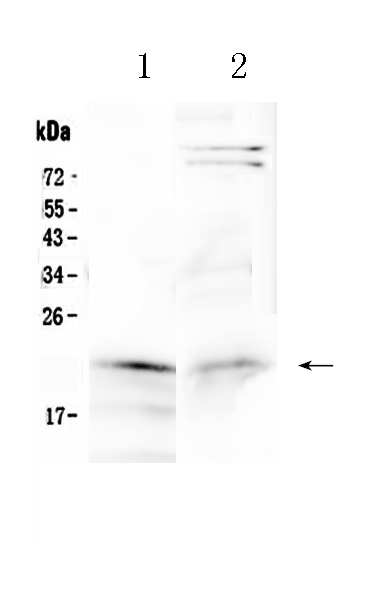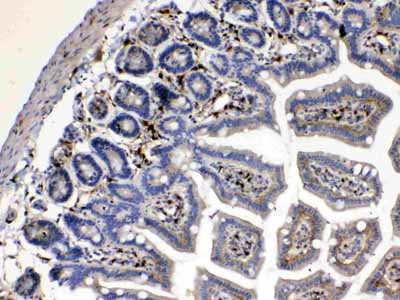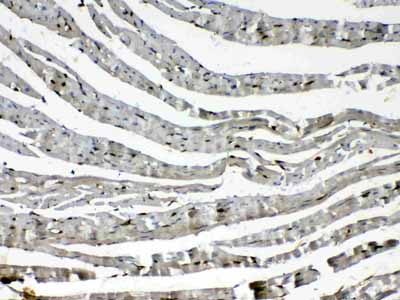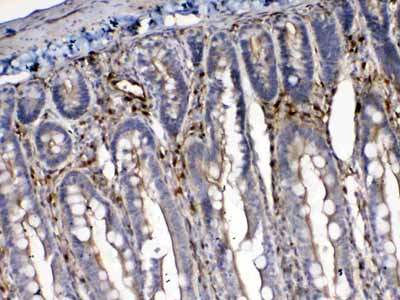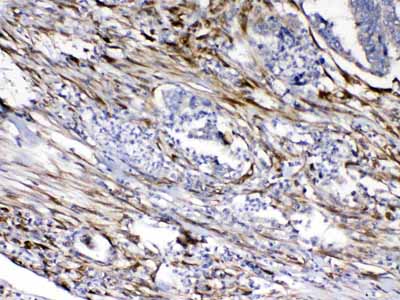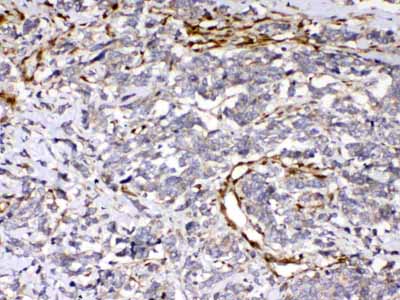Anti-Cytoglobin Picoband Antibody
- SPECIFICATION
- CITATIONS
- PROTOCOLS
- BACKGROUND

Application
| WB, IHC-P |
|---|---|
| Primary Accession | Q8WWM9 |
| Host | Rabbit |
| Reactivity | Human, Mouse, Rat |
| Clonality | Polyclonal |
| Format | Lyophilized |
| Description | Rabbit IgG polyclonal antibody for Cytoglobin(CYGB) detection. Tested with WB, IHC-P in Human;Mouse;Rat. |
| Reconstitution | Add 0.2ml of distilled water will yield a concentration of 500ug/ml. |
| Gene ID | 114757 |
|---|---|
| Other Names | Cytoglobin, Histoglobin, HGb, Stellate cell activation-associated protein, CYGB, STAP |
| Calculated MW | 21405 MW KDa |
| Application Details | Immunohistochemistry(Paraffin-embedded Section), 0.5-1 µg/ml, Human, Mouse, Rat, By Heat Western blot, 0.1-0.5 µg/ml, Mouse, Rat, Human |
| Subcellular Localization | Cytoplasm . |
| Tissue Specificity | Ubiquitously expressed. Highest expression in heart, stomach, bladder and small intestine. . |
| Protein Name | Cytoglobin |
| Contents | Each vial contains 5mg BSA, 0.9mg NaCl, 0.2mg Na2HPO4, 0.05mg NaN3. |
| Immunogen | E.coli-derived human Cytoglobin recombinant protein (Position: M1-P190). Human Cytoglobin shares 95.3% and 93.7% amino acid (aa) sequence identity with mouse and rat Cytoglobin, respectively. |
| Purification | Immunogen affinity purified. |
| Cross Reactivity | No cross reactivity with other proteins |
| Storage | At -20˚C for one year. After r˚Constitution, at 4˚C for one month. It˚Can also be aliquotted and stored frozen at -20˚C for a longer time.Avoid repeated freezing and thawing. |
| Name | CYGB (HGNC:16505) |
|---|---|
| Function | Probable multifunctional globin with a hexacoordinated heme iron required for the catalysis of various reactions depending on redox condition of the cell as well as oxygen availability (PubMed:11893755, PubMed:12359339, PubMed:15165856, PubMed:19147491, PubMed:20511233, PubMed:28393874, PubMed:28671819, PubMed:29128400, PubMed:33576020, PubMed:34930834). Has a nitric oxide dioxygenase (NOD) activity and is most probably involved in cell-mediated and oxygen-dependent nitric oxide consumption (PubMed:19147491, PubMed:20511233, PubMed:28393874, PubMed:28671819). By scavenging this second messenger may regulate several biological processes including endothelium-mediated vasodilation and vascular tone (PubMed:19147491, PubMed:28393874). Under normoxic conditions functions as a nitric oxide dioxygenase (NOD) but under hypoxic conditions the globin may switch its function to that of a nitrite (NO2) reductase (NiR), generating nitric oxide (PubMed:29128400). Could also have peroxidase and superoxide dismutase activities, detoxifying reactive oxygen species and protecting cells against oxidative stress (PubMed:12359339, PubMed:33576020, PubMed:34930834). Also binds dioxygen with low affinity and could function as an oxygen sensor but has probably no function as a respiratory oxygen carrier (PubMed:11893755, PubMed:15299006, PubMed:20553503). |
| Cellular Location | Cytoplasm. Nucleus |
| Tissue Location | Widely expressed. Highest expression in heart, stomach, bladder and small intestine. |

Thousands of laboratories across the world have published research that depended on the performance of antibodies from Abcepta to advance their research. Check out links to articles that cite our products in major peer-reviewed journals, organized by research category.
info@abcepta.com, and receive a free "I Love Antibodies" mug.
Provided below are standard protocols that you may find useful for product applications.
Background
Cytoglobin(CYGB), also called HGB or STAP, is a ubiquitously expressed hexacoordinate hemoglobin that may facilitate diffusion of oxygen through tissues, scavenge nitric oxide or other reactive oxygen species, or serve a protective function during oxidative stress. The cytoglobin gene is mapped on 17q25.1. The CYGB gene contains 4 exons and spans about 9 kb. Cytoglobin has many elements common to vertebrate globins, including invariant histidine residues, and the amino acids that form the heme pocket share similarity with pentacoordinate myoglobin. In contrast to the high oxygen affinities displayed by most hexacoordinate hemoglobins, the characteristics of CYGB indicate that it can facilitate oxygen transport. Because the oxygen affinity of CYGB is more similar to myoglobin than to neuroglobin, and the oxy form of CYGB resists autooxidation, CYGB is proposed to represent a tissue oxygen reservoir.
If you have used an Abcepta product and would like to share how it has performed, please click on the "Submit Review" button and provide the requested information. Our staff will examine and post your review and contact you if needed.
If you have any additional inquiries please email technical services at tech@abcepta.com.













 Foundational characteristics of cancer include proliferation, angiogenesis, migration, evasion of apoptosis, and cellular immortality. Find key markers for these cellular processes and antibodies to detect them.
Foundational characteristics of cancer include proliferation, angiogenesis, migration, evasion of apoptosis, and cellular immortality. Find key markers for these cellular processes and antibodies to detect them. The SUMOplot™ Analysis Program predicts and scores sumoylation sites in your protein. SUMOylation is a post-translational modification involved in various cellular processes, such as nuclear-cytosolic transport, transcriptional regulation, apoptosis, protein stability, response to stress, and progression through the cell cycle.
The SUMOplot™ Analysis Program predicts and scores sumoylation sites in your protein. SUMOylation is a post-translational modification involved in various cellular processes, such as nuclear-cytosolic transport, transcriptional regulation, apoptosis, protein stability, response to stress, and progression through the cell cycle. The Autophagy Receptor Motif Plotter predicts and scores autophagy receptor binding sites in your protein. Identifying proteins connected to this pathway is critical to understanding the role of autophagy in physiological as well as pathological processes such as development, differentiation, neurodegenerative diseases, stress, infection, and cancer.
The Autophagy Receptor Motif Plotter predicts and scores autophagy receptor binding sites in your protein. Identifying proteins connected to this pathway is critical to understanding the role of autophagy in physiological as well as pathological processes such as development, differentiation, neurodegenerative diseases, stress, infection, and cancer.
